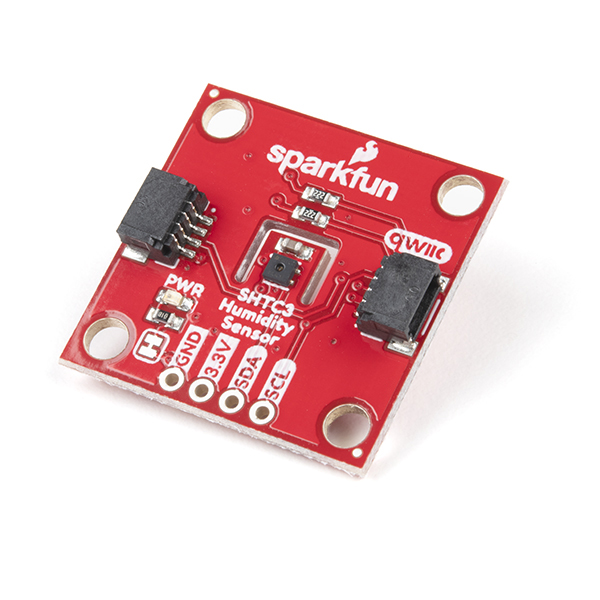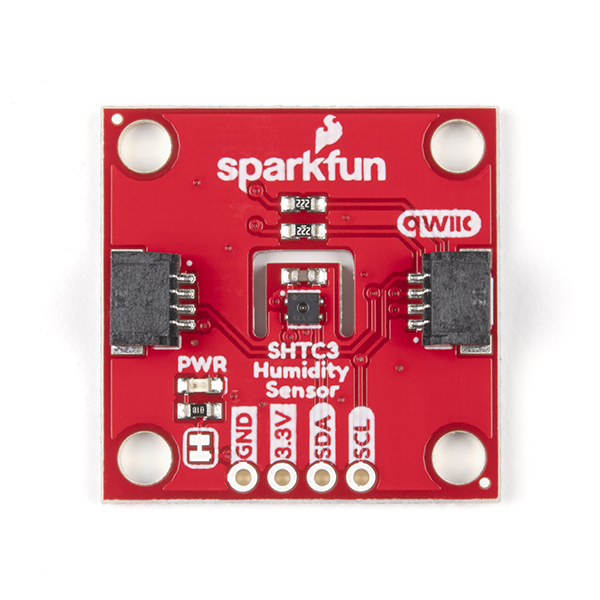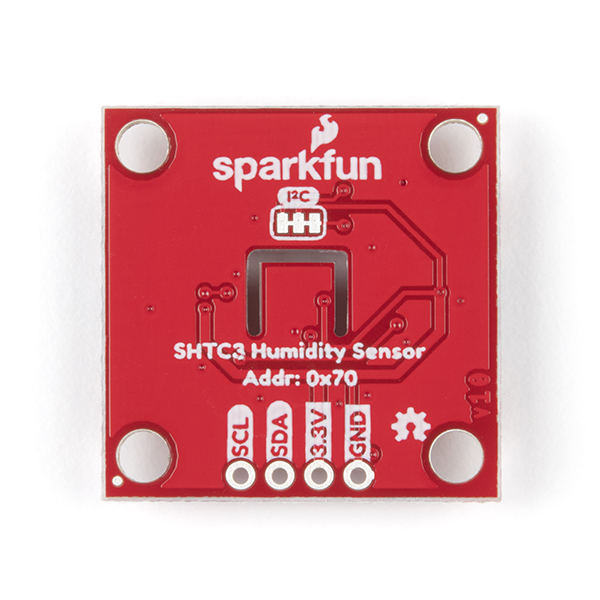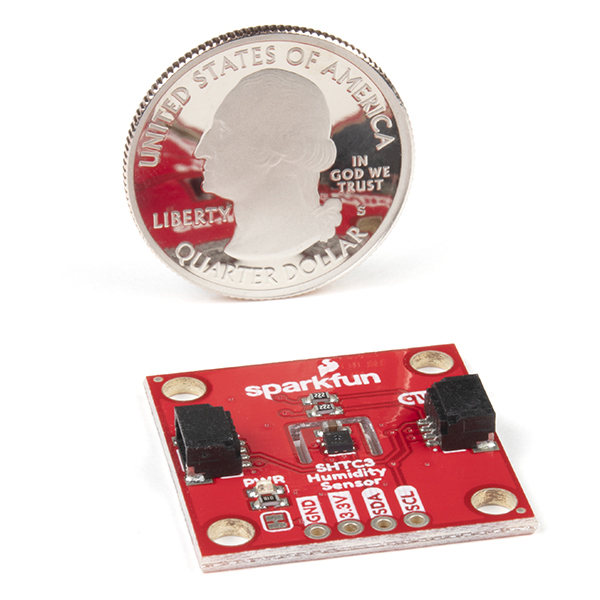SparkFun Humidity Sensor Breakout - SHTC3 (Qwiic)
Looking to keep a log of the climate in your greenhouse, create a humidor control system or want to track temperature and humidity data for a weather station project? The SparkFun SHTC3 Humidity Sensor may be the perfect option for you! The SHTC3 is a low cost, easy-to-use, highly accurate digital humidity and temperature sensor. The SHTC3 communicates via I2C so, as you can tell by the name, we have broken out the pins on the sensor to Qwiic connectors so you can easily connect it to SparkFun's ever growing Qwiic Ecosystem.
The SHTC3 digital humidity sensor from Sensirion builds on the success of their SHTC1 sensor with a broader supply voltage range (1.62V to 3.6V) and higher accuracy (±2% RH, ±0.2°C) than its predecessor, enabling greater flexibility. All you need are two lines for I2C communication, and you’ll have relative humidity readings and very accurate temperature readings as a bonus!
Hook up is a breeze as the breakout board is using the Qwiic connect system. The breakout board has built-in 2.2kΩ pullup resistors for I2C communications. If you’re hooking up multiple I2C devices on the same bus, you may want to disable these resistors.
Note: The I2C address of the SHTC3 is 0x70 and is hardware defined. A multiplexer/Mux is required to communicate to multiple SHTC3 sensors on a single bus.
The SparkFun Qwiic Connect System is an ecosystem of I2C sensors, actuators, shields and cables that make prototyping faster and less prone to error. All Qwiic-enabled boards use a common 1mm pitch, 4-pin JST connector. This reduces the amount of required PCB space, and polarized connections mean you can’t hook it up wrong.
The SHTC3 digital humidity sensor can also be automatically detected, scanned, configured, and logged using the OpenLog Artemis datalogger system. No programming, soldering, or setup required!
- Uses I2C interface (Qwiic-enabled)
- I2C Address: 0x70
- 2x Qwiic Connectors
- Operating voltage range
- 1.62V - 3.6 V
- Typically 3.3V if using the Qwiic cable
- Relative Humidity
- Operating range: 0% to 100%
- Typical accuracy: ±2 %RH
- Resolution: 0.01 %RH
- Temperature
- Operating range: -40°C to +125 °C
- Typical accuracy: ±0.2 °C
- Resolution: 0.01 °C
- Typical current consumption (varies based on mode)
- 4.9µA to 430µA (Normal Mode)
- 0.5µA to 270µA (Low Power Mode)
SparkFun Humidity Sensor Breakout - SHTC3 (Qwiic) Product Help and Resources
SparkFun Humidity Sensor Breakout - SHTC3 (Qwiic) Hookup Guide
May 7, 2020
A Hookup Guide to get started using the SHTC3 breakout.
SparkFun Indoor Air Quality Sensor - ENS160 (Qwiic) Hookup Guide
November 11, 2022
Is your air safe? Check your eCO2, TVOC, and AQI levels with the new SparkFun Indoor Air Quality Sensor - ENS160!
Core Skill: Programming
If a board needs code or communicates somehow, you're going to need to know how to program or interface with it. The programming skill is all about communication and code.
Skill Level: Rookie - You will need a better fundamental understand of what code is, and how it works. You will be using beginner-level software and development tools like Arduino. You will be dealing directly with code, but numerous examples and libraries are available. Sensors or shields will communicate with serial or TTL.
See all skill levels
Core Skill: Electrical Prototyping
If it requires power, you need to know how much, what all the pins do, and how to hook it up. You may need to reference datasheets, schematics, and know the ins and outs of electronics.
Skill Level: Rookie - You may be required to know a bit more about the component, such as orientation, or how to hook it up, in addition to power requirements. You will need to understand polarized components.
See all skill levels
Comments
Looking for answers to technical questions?
We welcome your comments and suggestions below. However, if you are looking for solutions to technical questions please see our Technical Assistance page.
Customer Reviews
5 out of 5
Based on 1 ratings:
1 of 1 found this helpful:
Easy to use, easy to deploy
I'm starting on a home cooking project using Qwiic sensors. This sensor was my first foray into the world of Qwiic, and the device has proved stable and resilient to my fumbling around with the RaspberryPI's I2C interface with i2c-tools and smbus2 python coding.





Gist breadcrumbs for others -- my Python and
smbus2code to interface with the SHTC3 from a RaspberryPI:GIST: SHTC3 and RaspberryPI over Qwiic
CC0 Public Domain
Hi, I've used the SHTC3 on a personal PCB design alongside an Si7021 temp and humidity sensor for redundancy. The board is designed to use one of a variety of microcontrollers to communicate with the two sensors over I2C. I'm using the SparkFun library to communicate with the SHTC3 IC. When I use an Arduino, ESP32, etc I can communicate with the SHTC3 and the Si7021 just fine. However, when I use any Particle device, I can only communicate with the Si7021 but not the SHTC3, thus I know I2C comms are working. I've used multiple Photons and even tried one of the mesh devices. I've also tried multiple of my own board. All result in the same inability to get data from the SHTC3. I posted about this on the Particle forums, but it's been almost a month with no response: https://community.particle.io/t/shtc3-temp-humidity-sensor-works-on-all-other-devices-except-particle-devices/55720
I was hoping someone at SparkFun could test this sensor with a Particle Photon to see if they get the same results? I would be very grateful! Thank you!
Hi Joel! To me, this sounds like an issue with clock stretching. The SHTC3 utilizes either clock stretching or it polls (pg.7) the SHTC3 while measurement is taking place. Particle Photon needs to have clock stretching specifically enabled in order for this sensor to be supported.
Does the sensor at least show up on an I2C bus scan?
Hey, Andy! No, it does not show up when I run the I2C scanner code. I will give the clock stretching a try.
Does anyone know if this will work with the OpenLog Artemis module?